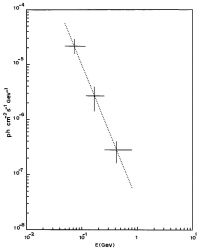Extragalactic
Extragalactic Gamma-Rays
 |
|
Figure 7: The energy spectrum of Quasar 3C273 obtained by COS-B |
In its low latitude and low altitude orbit SAS 2 was shielded from these events by the geomagnetic field. Secondly, the arrangement of the triggering telescope in the SAS 2 experiment made detection and rejection of alias-events more efficient.
On the other hand, it is highly likely that the high-latitude source 2CG289+64 is the quasar 3C273. This region of the sky has been subjected to repeated observations and the source has appeared in the three independent data sets. The combined data set gives a maximum likelihood source position to be that of 3C273 (Ref.4). The combined data yield the energy spectrum shown in figure 7, which when combined with data from other wavelengths demonstrates that the luminosity of 3C273 peaks in the gamma-ray region.
A systematic search of the data for further extragalactic sources by Pollock et al. (Ref.5) only confirmed the previous upper limits set by SAS 2.
As noted above the LMC and SMC could not be studied in detail because of viewing constraints and Earth in the field of view.
